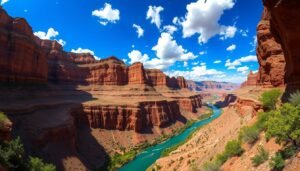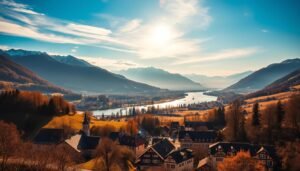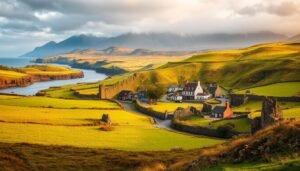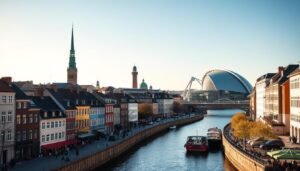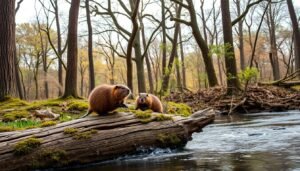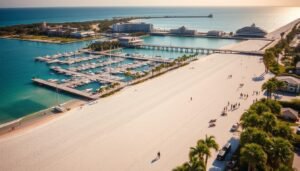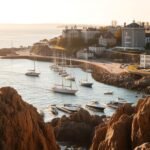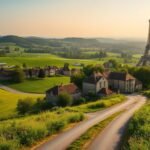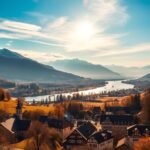Surprising fact: I learned that over 330 million people travel inside the United States each year, and many chase the same few iconic views that change how they see the country.
I put this friendly guide together because I wanted to share the towns, cities, and parks I truly loved. I describe routes that mix big-city museums and food with wild trails and cliffside overlooks.
I give clear ideas on how much time to spend and when to go so your trip fits your budget and curiosity. Expect practical tips on pairing cities like New York City, Chicago, Austin, and San Francisco with natural icons such as the Grand Canyon, Redwood National Park, and Glacier National Park.
My aim is simple: help you sketch a travel plan that keeps the best views and local people moments, while saving time and money so the experience feels effortless and memorable.
Key Takeaways
- I share a mix of cities and parks for balanced travel.
- Find quick tips on how many days to spend at each stop.
- Pairing nearby spots saves transit time and adds views.
- I note low-cost strategies like timing museum days.
- Flexible itineraries let your trip grow or shrink easily.
San Francisco, California: Iconic Views, Culture, and Coastal Vibes
San Francisco packs iconic views, tight-knit neighborhoods, and coastal escapes into a small, walkable area. I often recommend planning brief stays here because the city rewards curious wanderers without long transfers.
Best time and neighborhoods for food lovers
Plan for two to four days if you want time for classic viewpoints and relaxed food crawls. I look for neighborhoods where local spots cluster so you can move from coffee to dinner on foot.
- Start mornings in a market or cafe, then walk nearby galleries.
- Spend evenings near the waterfront for sunset and a cozy meal.
- Use transit and short walks to save time and money.
Half-day nature escapes: Muir Woods and coastal overlooks
A short drive or shuttle takes you from the urban grid to towering redwoods in under an hour. I like starting early for quieter trails and softer coastal light.
For a quick road trip loop, head north of the bridge for scenic overlooks, then drop back into town for a late lunch. This rhythm keeps your days easy and full of memorable views.
The Grand Canyon, Arizona: A National Park That Redefines “Grand”

I learned quickly that the Grand Canyon asks you to slow down and notice how light redraws every ridge. This national park delivers scale and color that stick with you long after the trip ends.
South Rim vs. North Rim: The South Rim is easy to reach and has more viewpoints and shuttles. The North Rim opens seasonally and feels quieter. Match your crowd tolerance and time with the rim that fits your style.
Hiking, safety, and reaching the bottom
Rim-to-river hikes are rewarding but strenuous. Plan turns well before fatigue sets in. Avoid peak summer heat; spring and autumn give better trail comfort.
Sunrise, sunset, and simple day plans
- Start early for sunrise viewpoints, then use shuttle loops midday.
- Carry extra water, layers, and sturdy shoes—hydration and footwear are essentials.
- Allow buffer for parking and traffic at the South Rim so your schedule stays calm.
These tips help you enjoy this canyon national treasure without overreaching. With modest planning, the Grand Canyon becomes a doable, inspiring destination rather than a rushed checklist.
Portland, Oregon: Laid-Back City Life with Easy Access to Nature
![]()
Portland’s easy transit and compact layout make it simple to stitch parks, coffee shops, and breweries into one relaxed day.
I rely on public transit and short walks here. That compact design means you can sample a food-forward day—coffee, food carts, then a dinner reservation—without renting a car.
NW 23rd (Nob Hill) is a great neighborhood loop for shopping, snacking, and people-watching. I like that indie shops and weekend markets sit close to green spaces, so nature breaks are never far.
Check current downtown conditions before you go; the city saw unrest in recent years, and a quick update keeps plans comfortable. If you drive in, use neighborhood garages and curbside apps for parking tips on a short road approach.
- Sample list for 24 hours: morning coffee, a market lunch, an afternoon park, and an evening brewpub.
- For 48 hours, add a museum, a longer park walk, and a neighborhood crawl through food cart pods.
- Only-in-Portland moments: a laid-back brewery chat, an indie art stop, and a riverside stroll between meals.
Overall, Portland’s relaxed culture and transit-friendly area make it easy to meet locals and explore without hurry. For a quick look at neighborhood attractions, see Portland attractions.
The Pacific Coastal Drive: Road Trip the West Coast for World-Class Views

I split the long shoreline into easy days so the scenery, not speed, defines the trip. This route from San Francisco north offers sheer cliffs, wide beaches, and pockets of ancient redwoods that demand pauses.
San Francisco to Portland: cliffside roads, redwoods, and beaches
Plan for slow progress. I break the San Francisco–Portland stretch into digestible segments so you can step out for short hikes and coastal lookouts without rushing.
- Stop towns like Mendocino, Bandon, and Coos Bay for walkable centers and good food.
- Pick quick walks under an hour at redwood groves and beach overlooks to stretch legs and shoot photos.
- Allow an extra day for fog or heavy swell—weather can change how a road feels.
Road trip tips: pacing, stops, and staying connected
I rely on an eSIM and cached maps before long stretches. That keeps me on route when connectivity fades and makes sharing updates simple.things-to-do-in-madrid
- Book the first night, then decide the next stay as you go for flexible lodging.
- Stock groceries for picnics at scenic pullouts; it saves time and gives ocean-side meals.
- My sunset ritual: find a quiet bluff, layer up, and let the world slow while the light falls.
Redwood National Park, California: Walk Among Giants

Rows of redwood giants create a kind of calm that settles the shoulders and slows your pace. This national park and its neighboring state parks protect huge stands of old-growth trees, picnic spots, and miles of trails that suit a quick loop or a longer trek.
Trail ideas for first-timers: pick short, flat loops that put trunks and canopy within arm’s reach. I like trails with well-graded surfaces and clear turnarounds so a half-day shows the scale without weariness.
I look for quiet groves off main loops where you can walk almost in silence. Pairing a forest stroll with a coastal stop is easy here; some hikes end where freshwater meets the Pacific and the sound of water adds to the mood.
- Park early for fewer people and easier parking at trailheads.
- Use picnic areas near campgrounds to slow down and soak up old-growth light.
- Stick to signed paths, protect fragile understory, and watch trail surfaces—roots and boardwalks are common.
I pack layers for cool, damp mornings and milder afternoons and keep a wide-angle lens handy to capture the trunks’ scale. With simple timing and respect for the land, this destination feels otherworldly and deeply restful.things-to-do-in-fredericksburg-tx
Glacier National Park, Montana: Mountains, Lakes, and Wild Country

I feel like every turnout here gives a new ridge or mirror lake that changes how I remember a trip.
I suggest two to three days so you catch signature viewpoints and fit one longer hike into your plan. Early season travel can mean partial closures, but that quiet often lifts the experience.
I map a first day for overlooks and lake time. The second day can aim for a mountain pass or valley hike and a longer trail. Watch weather windows for the best light across the ridgelines.
“Even a short visit can feel like the top of the world when peaks break through clouds.”
- Pick roadside pullouts for instant scale—minutes can yield huge views.
- Pack layers, snacks, and a small plan B if a trail closes.
- Build a buffer day in the state and check ranger updates before you go.
| Plan | Focus | Tip |
|---|---|---|
| Day 1 | Scenic overlooks & lakes | Start early for light and parking |
| Day 2 | Pass hike or valley trail | Watch forecasts for visibility |
| Buffer | Rest or alternate trail | Use ranger alerts for status |
Note: Timing your starts helps keep parking easy and gives you more quiet moments with the world-class scenery.
Austin, Texas: Live Music, Food Trucks, and Summer Energy

The city unwraps itself over long weekends: hot afternoons, cool nights, and sudden live sets.
I sketch a two-to-three-day plan that mixes daytime tacos, park strolls, and evening shows. Mornings start with coffee, a quick walk at Lady Bird Lake, and a taco stop that keeps the day easy.
I share simple tips for hopping between venues so you catch multiple sets without long waits. Ride-share runs and short walks work best; book the first show and wander for the next for happy serendipity.things-to-do-in-puerto-rico
Austin’s outdoor culture makes the life here feel alive even between sets. On hot days I aim for shaded patios, afternoon pool dips, or an early museum stop to cool down before night concerts.
- Neighborhood loop: Rainey Street for house bars, South Congress for bites, and a late set on East Austin.
- My quick morning routine: coffee, a park stroll, and a taco that doubles as lunch.
- Years of shows taught me when to book and when to wander for pop-ups and surprise sets.
“If you have only days, pick one outdoor music spot and one late-night dive—both tell different stories.”
Final tip: carry water, plan a rideshare for late returns, and keep a short list of go-to venues so you can plug in a last-minute set or pop-up with ease.
New Orleans, Louisiana: Culture, Cuisine, and the Joy of Live Jazz

The city greets you with trumpet notes and the scent of simmering gumbo on warm air.
I lay out a simple two-day rhythm that keeps time with meals and music. Start with a late breakfast, a history walk through the French Quarter, then a long lunch that stretches into a slow afternoon nap. Evening brings live jazz and late bites where street performers keep the night moving.
Neighborhoods matter: French Quarter courtyards, Marigny clubs, and Garden District stoops each mix culture and food so your trip feels rich and layered. I fit one guided tour into the plan for context, then spend free hours wandering alleys and listening for impromptu sets.
“Soak up each set and each plate—the city lingers long after the music fades.”
| When | What | Tip |
|---|---|---|
| Day 1 | Late breakfast; history walk; long lunch | Reserve popular restaurants; walk nearby for dessert |
| Night 1 | Live jazz & late bites | Find small clubs for spontaneous sets; use rideshares late |
| Day 2 | Gentle morning: coffee and beignets; photo stroll | Slow pace after late night; try a courtyard cafe |
I call out classic dishes—gumbo, jambalaya, beignets—and mark where you can try them at both wallet-friendly counters and sit-down spots. For safety, plan a simple late-night route and use trusted rideshare apps so you can relax and enjoy.
Photo-friendly corners, hidden courtyards, and open-door music moments make this place a vivid memory. Take your time, let the rhythm find you, and you’ll leave with a world of sounds and flavors in your heart.things-to-do-in-oahu
Chicago, Illinois: Lakefront City with Big Architecture and Bigger Eats

Chicago opens up in warm months with lake breezes, bold skyline views, and a street-food scene that pulls you outside.
Plan a sunny-day loop: start at Millennium Park, snap the sculpture, then walk the lakefront to Navy Pier. Add an architecture river cruise for a clear sense of the skyline and design.
I map two relaxed days so you mix marquee sights with neighborhood wandering and a night that highlights the food scene—from deep-dish pizza and classic hot dogs to chef-driven sushi.
“Arrive early for popular sights and linger by the water as locals do—sunsets here feel communal.”
- Use transit and walking to move quickly between museums and lakeside parks.
- Consider a short road trip detour north for beaches or scenic suburbs if you extend your stay.
- Have a bad-weather backup: an aquarium visit, indoor market, or museum keeps the day fun.
| Focus | When | Tip |
|---|---|---|
| Lakefront loop | Morning–afternoon | Start early for light and fewer lines |
| Architecture cruise | Afternoon | Book ahead; boats fill fast in summer |
| Evening dinner | Night | Reserve seating for busy neighborhoods |
I watch the crowd energy and slip into quieter corners when I need a breather. With simple timing and a few reservations, this city yields big memories without a fuss.
New York City, New York: The City That Never Sleeps

I arrange flexible days that balance marquee sights with quieter neighborhood walks. I suggest planning two to four days so you can hit icons and still leave room for surprise moments.
My approach saves time in lines and keeps energy up. I pick a few neighborhoods each day and walk between them. That way the trip feels like living there, not racing a checklist.
I plan meals ahead for must-try spots, then leave space for spontaneous bites at corner cafes. I point you toward parks, small venues, and sunset viewpoints that shape the city’s experience and show why the world notices its skyline.things-to-do-in-lisbon
“Stand back on a high viewpoint and the whole city feels like a map you can step into.”
- Use off-peak hours for museums and observatories to avoid crowds.
- Map an evening arc: pre-show dinner, performance, then late dessert.
- Keep a short rainy-day list: museum, covered market, and a classic neighborhood cafe.
For moving quickly and cheaply, favor subway hops and short walks. I add a few extra ideas you can slot into your plans if you have a day more—a slow ferry ride, a rooftop bar, or a longer neighborhood stroll through lesser-known places.
Washington, D.C.: Smithsonian Days and Monument Nights
You can thread a museum morning and an evening monument loop into one satisfying day. I like starting at the National Mall and picking two Smithsonian museums that match my mood. That focus keeps each day light and deep at once.
My rule: visit two museums, then take a long walk through parks for lunch and fresh air. The midday stroll resets energy and helps you absorb exhibits without rushing.
After hours, I do an evening monument loop. The lighting is softer, crowds thin, and the monuments feel quieter. That time makes history feel personal and slow.
I move by Metro and short walks; transit keeps costs down and saves time between sites. For food, I favor quick museum cafes and nearby casual counters so I can return to galleries fast.
- Pair Capitol Hill with a museum morning for an architecture-and-history arc.
- Watch season crowds—school calendars change how busy galleries are.
- Kid-friendly shortlist: a small park break, a hands-on museum, and a relaxed picnic.
“Build spare minutes into your plan—stories land differently when the city quiets.”
Miami, Florida: Beaches, Cuban Flavor, and Nonstop Nightlife
I find Miami’s energy easiest to enjoy when I frame each day around the coast and a few good meals.
Start with a beach-first day: plan easy access to water, take shaded breaks, and aim for a relaxed late lunch. Early mornings and late evenings feel best during summer heat; those hours keep the day comfortable and lively.
I anchor afternoons with Cuban-inspired coffee and bold flavors that carry the neighborhood mood. For evenings, I build a simple arc: sunset on the coast, dinner, and dancing nearby so the night flows without fuss.
- Rent a bike or stroll the boardwalk for light movement and photo stops.
- Pack breathable layers, sun protection, and a small day bag for shade breaks.
- Use rideshares and designated lots to save time circling for parking.
If I add a second day, I slot an art-district walk or a short boat tour so the trip stays beach-forward. These moves keep the experience relaxed and let you leave recharged.
“Keep minutes loose and stay close to the water—Miami rewards simple plans and big flavors.”
San Diego, California: Sunshine, Surf, and Outdoor Living
San Diego rolls sunshine and surf into an easy rhythm that makes outdoor days feel effortless. I sketch a breezy two-day plan: beach mornings, taco lunches, and golden-hour walks along the waterfront.
The Gaslamp Quarter and Pacific Beach give clear arcs for dining and nightlife. Coastal neighborhoods make beach hopping simple and keep outdoorsy days flowing from coffee to surf to sunset.things-to-do-in-mexico-city
I add quick road trip advice for stringing San Diego into a longer West Coast route. Aim for short detours so you do not lose surf time and keep fuel and timing simple.
- Parking tips: arrive early at popular beaches in summer and look for neighborhood lots.
- Combine a harbor walk with a museum or a park stop for balance between city and sea.
- Kid-friendly coves offer calmer swims; sunrise options suit early birds, and after-dark bar hops suit night owls.
I pack layers for cool evenings and sun care for bright days. For the best way to move around, choose bike, car, or scooter based on your area and plans.
things to do in San Diego is a handy link if you want more local ideas and practical tips for your travel.
Lake Tahoe, California/Nevada: Crystal Water, Mountains, and Four-Season Fun
Lake Tahoe wakes slow mornings with glassy water and sharp mountain light.
I usually plan one clear day that starts on or near the water, then climbs into the mountains for a late-afternoon viewpoint. Early mornings beat the beach crowds and open quieter coves for a short paddle or shoreline walk.
Summer tips: arrive before mid-morning, park at smaller trailheads, or use a shuttle to reach less crowded beaches. If you hike, pick routes that return before dusk so you catch both mountain and lake panoramas without a long slog.
I favor a lakeside spot for sunset and a casual dinner afterward; it keeps the vibe relaxed and ends the trip on a calm note. Cross-state logistics matter—watch for differing parking rules, permits, and variable road speeds between California and Nevada.
“Clear evenings can cool fast; pack layers so the last light stays comfortable.”
- Rent or book a shuttle for busy weekends.
- Consider shoulder-season travel when rates drop and trails stay beautiful.
- Respect alpine rules: pack out trash and stay on marked paths to keep Tahoe blue.
| Plan | Why | Tip |
|---|---|---|
| Morning | Water time for calm photos and paddles | Arrive early; use public lots |
| Afternoon | Short mountain hike with views | Choose a 2–4 hour loop |
| Evening | Sunset and lakeside dinner | Pack layers; reserve dining in season |
If the lake steals your heart: add a night and wake for another quiet morning—Tahoe rewards slow plans and small detours.
Las Vegas, Nevada: Beyond the Strip—A Desert Gateway
From neon nights to quiet desert mornings, Las Vegas makes a convenient hub for varied trips.
I use the city as a base: long evenings of dining and shows, and early mornings on scenic drives. Many national parks and desert loops sit within easy reach, so you can return to the Strip each night without hauling camp gear.
Day trips and national parks within road-trip range
Quick day loops: Red Rock Canyon and Valley of Fire work well for same-day returns. Plan an overnight for the Grand Canyon West or Zion for more hiking time.
- Start before sunrise for cooler air and better light.
- Budget extra time for scenic detours and photo stops—add at least 30–60 minutes per planned overlook.
- Bring spare water, a full tank of fuel, and offline maps for reliable navigation.
“Balance late-night shows with early starts—sleep a bit earlier or pick one late evening so daylight trips stay fun.”
| Trip type | Range | Timing tip |
|---|---|---|
| Half-day loop | Red Rock, Valley of Fire | Leave at dawn; return by midafternoon |
| Full day | Hoover Dam, Lake Mead | Pack lunch; expect some driving time |
| Overnight | Zion, Grand Canyon West | Book lodging nearby; allow sunrise next day |
| City reset | Quiet hotels & local parks | Use off-Strip neighborhoods to unwind |
Packing and practical tips: sunscreen, light layers for shifting desert temps, and a small first-aid kit. After a day outdoors, pick a relaxed dinner-show combo near your hotel so the evening feels easy rather than like a lot of effort.
I also keep a short list of quieter spots off the Strip—small cafés, neighborhood parks, and low-key viewpoints—where I can reset after neon. For more local routes and options, see these hidden gems around Las Vegas.
best places to visit in usa: National Parks and Cities I Keep Returning To
Some trips tell stories in stone; Zion and the surrounding parks are full of those chapters. I return because the red walls feel alive with time and change as the light moves.
Zion National Park has routes that range from short overlooks to full canyon hikes. The Narrows can be magical when river flows allow, and autumn often offers cooler days and thinner crowds.
I plan early starts, check water flow and permit needs, and fit one long hike with shorter walks the same day. For a compact road trip, I link Zion, Bryce, and Capitol Reef so driving never dominates the trip.
Zion National Park and Canyon Country: hikes, canyons, and epic red rock
Match your hike choice to conditions. Slot canyons, riverside walks, and ridge overlooks all feel different and require different gear.
Savannah and Charleston: history, food, and walkable charm
Those cities reward slow mornings in shaded squares and long lunches that stretch into the afternoon. I love the layered history, the porches, and meals that tell local stories.
Denver and the Rockies: craft brews, parks, and mountain day trips
Denver mixes city life with easy mountain escapes. I plan one Front Range day, a brewery stop, and a soak at nearby hot springs when time allows.
- Pack layers and canyon-friendly footwear.
- Space meals around active days so energy lasts for afternoon hikes.
- Book permits or shuttles ahead and check trail updates the day before.
“A little planning goes a long way; leave room for a stray turn or a local tip.”
| Area | Why I Return | Quick tip |
|---|---|---|
| Zion National Park | Epic canyons, varied hikes, dramatic light | Check river flow; start early |
| Canyon National region | Arches, Bryce, Canyonlands diversity | Link parks into short drives; avoid midday heat |
| Savannah & Charleston | Walkable history and standout Southern food | Save slow mornings for shaded squares |
| Denver & Rockies | City comforts plus mountain day trips | Plan one hike and one brewery or hot springs day |
My simplest rule: give each place one focused day, pace yourself, and let the experience sink in. That way the trip stays full of surprises, not checklists.
Conclusion
I wrap this guide with a simple framework: pick two anchor cities, then weave one or two national park stops between them by road. That approach keeps driving manageable and gives you time for sunrise and sunset windows that matter most.
I note hubs like Las Vegas or Denver for easy access to canyon national routes and mountain hot springs. For the Grand Canyon or rim-to-river efforts, prepare for steep changes and carry extra water and shade.
Leave spare hours in your plan, pack for both city nights and outdoors days, and trim costs by booking one flexible night at a time. Years of travel taught me that a little breathing room turns a good trip into one that stays in your heart.






